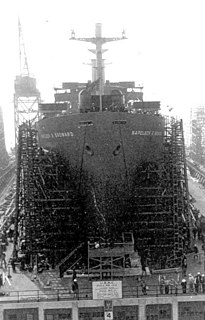
USS Pakana (AT–108) was an Abnaki-class fleet ocean tug. It was named after the Pakana, a Native American tribe of Texas. This ship saw service in the Pacific theater of World War II, and was later transferred to the United States Bureau of Mines for use in Alaska before being deliberately sunk in 1975.

USS Crater (AK-70) was the lead ship of her class of converted liberty ship cargo ships in the service of the US Navy in World War II. She was first named after John James Audubon, an American ornithologist, naturalist, and painter. She was renamed and commissioned after the constellation Crater, she was the only ship of the Navy to bear this name.

USS Reclaimer (ARS-42), was a Bolster-class rescue and salvage ship of the United States Navy. It was the only ship of the US Navy to be named Reclaimer.

USS Luzon (ARG-2) was an internal combustion engine repair ship that saw service in the United States Navy during World War II. She was the lead ship in a class of twelve and was named for the Island of Luzon, the chief island in the northern Philippines and site of the capital city of Manila. She is the second US Naval vessel to bear the name.

USS LST-31 was a United States Navy LST-1-class tank landing ship used exclusively in the Asiatic-Pacific Theater during World War II. Like many of her class, she was not originally named and is properly referred to by her hull designation. Later she was named for Addison County, Vermont. She was the only US Naval vessel to bear the name.

USS Egeria (ARL-8) was one of 39 Achelous-class landing craft repair ships built for the United States Navy during World War II. Named for Egeria, she was the only U.S. Naval vessel to bear the name.

USS Matar (AK-119) was a Crater-class cargo ship, converted from a Liberty Ship, commissioned by the US Navy for service in World War II. She was first named after Napoleon B. Broward, an American river pilot, captain, and politician; he was elected as the 19th Governor of the US state of Florida. She was renamed and commissioned after Matar, a binary star in the constellation of Pegasus. She was responsible for delivering troops, goods and equipment to locations in the war zone.

USS Lesuth (AK-125) was a Crater-class cargo ship commissioned by the US Navy for service in World War II. Lesuth was named after the star Lesuth in the constellation Scorpius. She was responsible for delivering troops, goods and equipment to locations in the Asiatic-Pacific Theater.

USS Megrez (AK-126) was a Crater-class cargo ship commissioned by the US Navy for service in World War II. Megrez was named after Megrez, a star in the constellation Ursa Major. She was responsible for delivering troops, goods and equipment to locations in the Asiatic-Pacific Theater.

USS Grapple (ARS-7) is a Diver-class rescue and salvage ship commissioned in the United States Navy from 1943 to 1946 and from 1951 to 1977. In 1977, she was sold to Taiwan and was renamed ROCS Da Hu (ARS-552).

USS Preserver (ARS-8) was a Diver-class rescue and salvage ship commissioned by the U.S. Navy for service in World War II. She was responsible for coming to the aid of stricken vessels.

USS Shackle (ARS-9) was a Diver-class rescue and salvage ship commissioned by the U.S. Navy for service in World War II. She was responsible for coming to the aid of stricken vessels.
USS Deliver (ARS-23) was a Diver-class rescue and salvage ship commissioned by the U.S. Navy during World War II. Her task was to come to the aid of stricken vessels.
USS Vent (ARS-29) was a Diver-class rescue and salvage ship commissioned by the U.S. Navy during World War II. Her task was to come to the aid of stricken vessels.
USS Gear (ARS-34) was a Diver-class rescue and salvage ship acquired by the U.S. Navy during World War II. Her task was to come to the aid of stricken vessels.

USS Bolster (ARS-38) was a Bolster-class rescue and salvage ship acquired by the U.S. Navy during World War II, the Korean War and the Vietnam War. Her task was to come to the aid of stricken vessels.
USS Kerstin (AF-34) was an Adria stores ship acquired by the U.S. Navy for service in World War II. Her task was to carry stores, refrigerated items, and equipment to ships in the fleet, and to remote stations and staging areas.

USS Kern (AOG-2) was a Patapsco-class gasoline tanker acquired by the United States Navy for the dangerous task of transporting gasoline to warships in the fleet, and to remote Navy stations.

USS Nemasket (AOG-10) was a Patapsco-class gasoline tanker in service with the U.S. Navy from 1944 to 1959. She was scrapped in 2006.

USS Livingston (AP-163/AK-222) was a Crater-class cargo ship built for the US Navy during World War II. She was responsible for delivering troops, goods and equipment to locations in the Asiatic-Pacific Theater.















